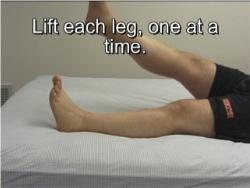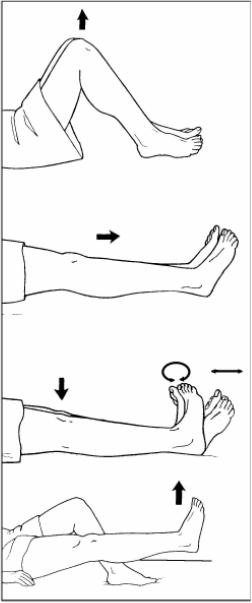
|
Lesson 8: Perioperative Patient Care
8-23. POSTOPERATIVE PATIENT CARE ACCORDING TO BODY SYSTEM
a. Respiratory System. The cough reflex is suppressed during surgery and mucous accumulates in the trachea and bronchi. After surgery, respiration is less effective because of the anesthesia and pain medication, and because deep respirations cause pain at the incision site. As a result, the alveoli do not inflate and may collapse, and retained secretions increase the potential for respiratory infection and atelectasis.
(1) Turn the patient as ordered.
(2) Ambulate the patient as ordered.
(3) If permitted, place the patient in a semi-Fowler's position, with support for the neck and shoulders, to aid lung expansion.
(4) Reinforce the deep breathing exercises the patient was taught preoperatively. Deep breathing exercises hyperventilate the alveoli and prevent their collapse, improve lung expansion and volume, help to expel anesthetic gases and mucus, and facilitate oxygenation of tissues. Ask the patient to:
(a) Exhale gently and completely.
(b) Inhale through the nose gently and completely.
(c) Hold his breath and mentally count to three.
(d) Exhale as completely as possible through pursed lips as if to whistle.
(e) Repeat these steps three times every hour while awake.
(5) Coughing, in conjunction with deep breathing, helps to remove retained mucus from the respiratory tract. Coughing is painful for the postoperative patient. While in a semi-Fowler's position, the patient should support the incision with a pillow or folded bath blanket and follow these guidelines for effective coughing:
(a) Inhale and exhale deeply and slowly through the nose three times.
(b) Take a deep breath and hold it for 3 seconds.
(c) Give two or three "hacking" coughs while exhaling with the mouth open and the tongue out.
(d) Take a deep breath with the mouth open.
(e) Cough deeply once or twice.
(f) Take another deep breath.
(g) Repeat these steps every 2 hours while awake.
(6) An incentive spirometer may be ordered to help increase lung volume, inflation of alveoli, and facilitate venous return. Most patients learn to use this device and can carry out the procedure without a nurse in attendance. Monitor the patient from time to time to motivate them to use the spirometer and to be sure that they use it correctly.
(a) While in an upright position, the patient should take two or three normal breaths, then insert the spirometer's mouthpiece into his mouth.
(b) Inhale through the mouth and hold the breath for 3 to 5 seconds.
(c) Exhale slowly and fully.
(d) Repeat this sequence 10 times during each waking hour for the first 5 post-op days. Do not use the spirometer immediately before or after meals.
b. Cardiovascular System. Venous return from the legs slows during surgery and may actually decrease in some surgical positions. With circulatory stasis of the legs, thrombophlebitis and emboli are potential complications of surgery. Venous return is increased by flexion and contraction of the leg muscles.
(1) To prevent thrombophlebitis, instruct the patient to exercise the legs while on bedrest. Leg exercises are easier if the patient is in a supine position with the head of the bed slightly raised to relax abdominal muscles. Leg exercises (figure 8-8) should be individualized using the following guidelines.
(a) Flex and extend the knees, pressing the backs of the knees down toward the mattress on extension.
(b) Alternately, point the toes toward the chin (dorsiflex) and toward the foot of the bed (plantar flex); then, make a circle with the toes.
(c) Raise and lower each leg, keeping the leg straight.
(d) Repeat leg exercises every 1 to 2 hours.
(2) Ambulate the patient as ordered.
(a) Provide physical support for the first attempts.
(b) Have the patient dangle the legs at the bedside before ambulation.
(c) Monitor the patient's blood pressure while he dangles.
(d) If the patient is hypotensive or experiences dizziness while dangling, do not ambulate. Report this event to the supervisor.
c. Urinary System. Patients who have had abdominal surgery, particularly in the lower abdominal and pelvic regions, often have difficulty urinating after surgery. The sensation of needing to urinate may temporarily decrease from operative trauma in the region near the bladder. The fear of pain may cause the patient to feel tense and have difficulty urinating.
(1) If the patient does not have a catheter, and has not voided within eight hours after return to the nursing unit, report this event to the supervisor.
(2) Palpate the patient's bladder for distention and assess the patient's response. The area over the bladder may feel rounder and slightly cooler than the rest of the abdomen. The patient may tell you that he feels a sense of fullness and urgency.
(3) Assist the patient to void.
(a) Assist the patient to the bathroom or provide privacy.
(b) Position the patient comfortably on the bedpan or offer the urinal.
(4) Measure and record urine output. If the first urine voided following surgery is less than 30 cc, notify the supervisor.
(5) If there is blood or other abnormal content in the urine, or the patient complains of pain when voiding, report this to the supervisor.
(6) Follow nursing unit standing operating procedures (SOP) for infection control, when caring for the patient with a Foley catheter.
d. Gastrointestinal System. Inactivity and altered fluid and food intake during the perioperative period alter gastrointestinal activities. Nausea and vomiting may result from an accumulation of stomach contents before peristalsis returns or from manipulation of organs during the surgical procedure if the patient had abdominal surgery.
(1) Report to the supervisor if the patient complains of abdominal distention.
(2) Ask the patient if he has passed gas since returning from surgery.
(3) Auscultate for bowel sounds. Report your assessment to the supervisor, and document in nursing notes.
(4) Assess abdominal distention, especially if bowel sounds are not audible or are high-pitched, indicating an absence of peristalsis.
(5) Provide a privacy so that the patient will feel comfortable expelling gas.
(6) Encourage food and fluid intake when the patient in no longer NPO.
(7) Ambulate the patient to assist peristalsis and help relieve gas pain, which is a common postoperative discomfort.
(8) Instruct the patient to tell you of his first bowel movement following surgery. Record the bowel movement on the intake and output (I&O) sheet.
(9) If nursing measures are not effective, the doctor may order medication or an enema to facilitate peristalsis and relieve distention. A last measure may require the insertion of a nasogastric or rectal tube.
(10) Document nursing measures and the results in the nursing notes.
e. Integumentary System. Follow doctor's orders for wound care, wound irrigations and cultures. In addition to assessment of the surgical wound, you should evaluate the patient's general condition and laboratory test results. If the patient complains of increased or constant pain from the wound, or if wound edges are swollen or there is purulent drainage, further assessment should be made and your findings reported and documented. Generalized malaise, increased pain, anorexia, and an elevated body temperature and pulse rate are indicators of infection. Important laboratory data include an elevated white blood cell count and the causative organism if a wound culture is done. Staples or sutures are usually removed by the doctor using sterile technique. After the staples or sutures are removed, the doctor may apply Steri-Strip® to the wound to give support as it continues to heal.
|
Precautions for Contact with Blood and Body Fluids
|
(1) There are two methods of caring for wounds: the open method, in which no dressing is used to cover the wound, and the closed method, in which a dressing is applied. The basic objective of wound care is to promote tissue repair and regeneration, so that skin integrity is restores. Dressings have advantages and disadvantages.
(a) Advantages. Dressings absorb drainage, protect the wound from injury and contamination, and provide physical, psychological, and aesthetic comfort for the patient.
(b) Disadvantages. Dressings can rub or stick to the wound, causing superficial injury. Dressings create a warm, damp, and dark environment conducive to the growth of organisms and resultant infection.
(2) At some time, most wounds are covered with a dressing and you may be responsible for changing the dressing. First, gather needed supplies. Items may be packaged individually or all necessary items may be in a sterile dressing tray. Some surgical units have special dressing carts, with agents needed to clean the wound, and materials to cover and secure the dressing. Next, prepare the patient for the dressing change by explaining what will be done, providing privacy for the procedure, and assisting the patient to a position that is comfortable for him and for you. Finally, use appropriate aseptic techniques when changing the dressing and follow precautions for contact with blood and body fluids. The most common cause of nosocomial infections is carelessness in observing medical and surgical asepsis when changing dressings. It is especially important to wash hands thoroughly before and after changing dressings and to follow the Centers for Disease Control (CDC) guidelines (figure 8-9).
8-24. GENERAL POSTOPERATIVE NURSING IMPLICATIONS
|
a. Monitor vital signs as ordered.
b. Report elevated temperature and rapid/weak pulse immediately to supervisor (infection).
c. Report lowered blood pressure and increased pulse to supervisor (hypovolemic shock).
d. Administer analgesics as ordered.
e. Apply all nursing implications related to the patient receiving analgesics whether narcotic or nonnarcotic, to include the following.
(1) Check each medication order against the doctor's order.
(2) Prepare the medications (check labels, accurately calculate dosages, observe proper asepsis techniques with needles and syringes).
(3) Check the patient's identification wristband to ensure positive identification before administering medications.
(4) Administer the medications. Offer each drug separately if administering more than one drug at the same time.
(5) Remain with the patient and see that the medication is taken. Never leave medications at the bedside for the patient to take later.
(6) Document the medications given as soon as possible.
f. Administer IV fluids as ordered. Maintain and monitor all IV sites. Follow SOP for infection control.
g. Participate with the health team in the patient's nutrition therapy.
h. Apply all nursing implications related to the patient diets (serving, recording intake, and food tolerance).
i. Coordinate with team leader for "take-home" wound care supplies and prescriptions for self-administration.
j. Prepare the patient and the family for disposition (transfer, return to duty, discharge). Supply the patient or family member with written instructions for:
(1) Wound care.
(2) Medications.
(3) Making outpatient appointments.
(4) An emergency, including the phone numbers for doctors and/or clinics.
k. Document the patient's disposition in the nurse's notes in accordance with unit SOP.
Surgical intervention often alters physical appearance and normal physiological functions and may threaten the patients psychological security. Any or all of these may lead to alterations in the patient's self-concept and body image. Some surgical patients react to the loss of a body part as to a death. Be aware of the patient's needs and establish interventions that will support his strengths and effective coping skills. The nursing process is used throughout the perioperative period to provide the patient with individualized care and the knowledge and ability for self-care following disposition.

